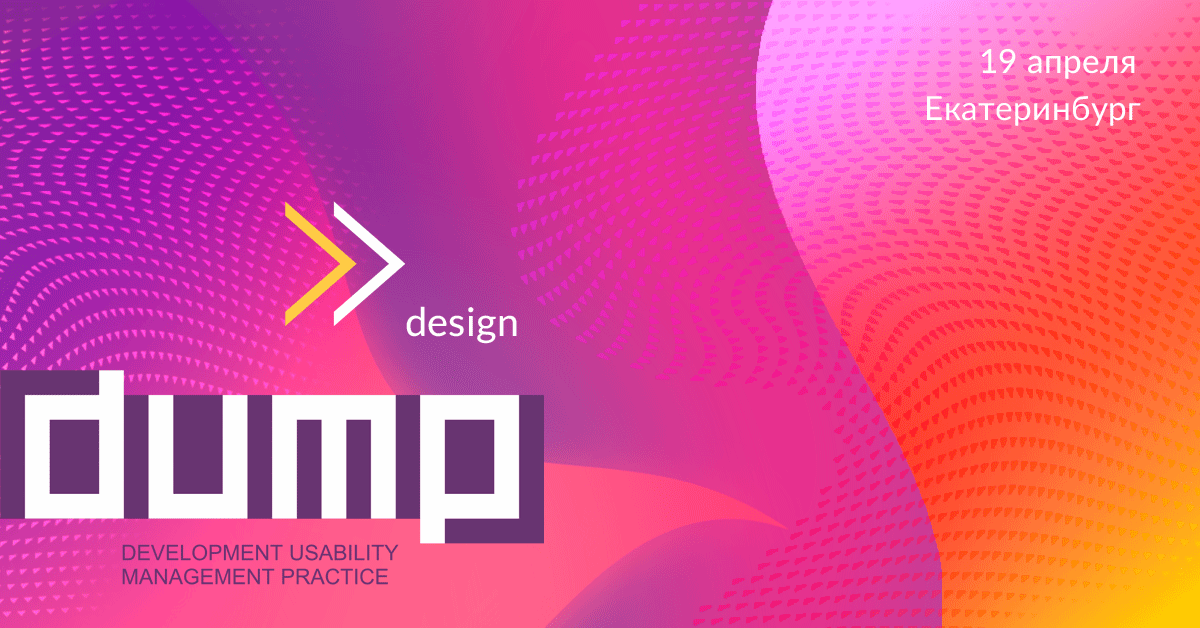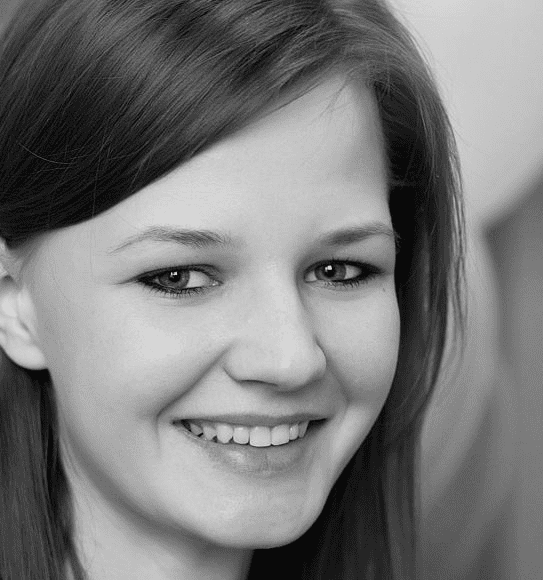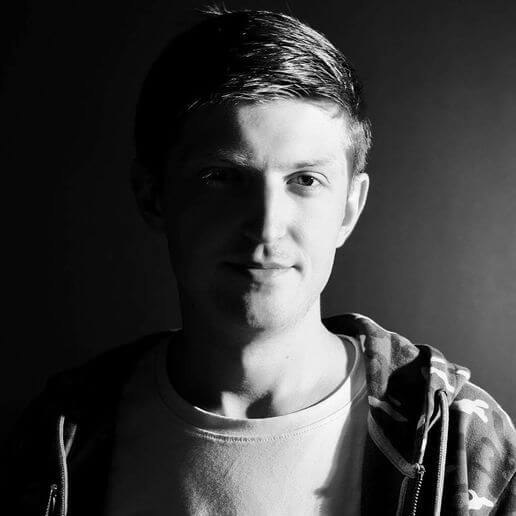What designers are waiting for at DUMP-2019: a review of the Design section
It remains two weeks before the largest developer conference in the Urals DUMP , which will be held on April 19 in Yekaterinburg.
Program Design Directors Alexey Kulakov (Jetstyle, Ridero) and Andrei Shapiro (Byndysoft) told that they would be interested in the section, and what designers would learn by listening to the reports.

')
Our section is not about pictures and “pretty”, but about how to solve user tasks through interfaces. Therefore, we will talk a lot about user scenarios and the practical application of various UX approaches.
And we will tell about where to develop the designer, not to remain an eternal strong middling, where to get inspiration if you work with the same product, and step on the sore - protection of design and feedback.
 Error driven design
Error driven design
Alena Kirdina (Evil Martians)
A. Kulakov: I like this report, because it is about the very essence of interface design. About how to make a design without opening a graphic editor at all. From the new for me personally - the formulated principle of analyzing the logs of the frequency of errors as a metric and method of decision making
You will leave this report, having plus one new method of making decisions about where in the interface to bring order. And with examples of how this can be done, throwing out pieces of experience from the interface, rather than adding.
 "Magic Generative design - how to master the designer?"
"Magic Generative design - how to master the designer?"
Konstantin Ostroukhov (JetStyle)
A. Kulakov: Last year we already had a report on generative design at DUMP. In some ways, this is a continuation of the theme - new tools, new techniques for working with generative design. I like the report that he is inspiring and instrumental at the same time. Kostya shows how he (almost every day) sketches in a generative design, and gives an overview of the tools of generative design that can do this. I just once again want to learn the java script to start doing beauty generated from the user's experience. Where else to take time?
 “Simple ways to get to know your user and not screw it up”
“Simple ways to get to know your user and not screw it up”
Anastasia Shapovalova (Naumen)
A. Shapiro: An Experimental Product Approach from the Naumen Trenches. In working with interfaces, there is a visual part, which is easier to talk to everyone, and the most important part is the backstage, associated with research. Anastasia talks about her experience when she, using an interesting tool for monitoring user sessions, debunks her illusions about customers. Another example from practice will show how, making a mistake and pouring out changes instead of a narrow group of users at all, find the use of newly acquired knowledge.
 “Service Design and Customer Experience Management: is it new or is it the same, but in other words?”
“Service Design and Customer Experience Management: is it new or is it the same, but in other words?”
Alexandra Rudenko (Service Design Bureau)
A. Kulakov: This is a description of another approach to managing people's experience. Interesting, because from personal practice and based on a completely scientific base. And no, this is not another dispute about terms. I very much share the author's approach to the problem of the integrity of experience, although I myself use a different set of favorite practices for the same task.
From this report you will leave with a clear description of the CX-design toolkit. And also, if you have ever painted giant CJM (customer journey map) and thought “how can you structure it all?”, You will need an approach that emphasizes individual episodes of experience, which is very clearly described in the report.
 "Evil interfaces or black UX in action"
"Evil interfaces or black UX in action"
Sasha Ilyuschenko (SEMrush)
A. Shapiro: Sasha will slightly open the world of “dark” interface approaches to us and show how, without going beyond the unacceptable edge, to study the desires of users of the product. Apply a clever trick, but do not cheat. Do not spend money on the production of a new feature, but find out whether it will be used.
 "Animation in Interfaces"
"Animation in Interfaces"
Dmitry Novikov (MacPaw)
A. Shapiro: Animation has been in trend for a long time. How to make an animation well, how not to overdo it, how to understand where the line between exquisite and deliberate, how to voice the animation and not overcome this user - all this is illustrated by Dmitry’s examples illustrated.
 “I want to be an art director, but can I go straight from home?” I am looking for a mentor, but where are they issued? ”
“I want to be an art director, but can I go straight from home?” I am looking for a mentor, but where are they issued? ”
Daria Prokuda (BeaversBrothers)
A. Kulakov: This is a very instrumental report about how to become an art director faster and about where to get an art director (if you don’t have, and you need to). Dasha talks about how mentoring is arranged in courses that teach design, what role the art director plays there, how to start doing it, and what is the difference with the art direction in the working teams.
You will leave this report with the thought “should I try myself as a mentor” and understand how to start it and how much I will have to spend on it.
 “How to present design to non-designers”
“How to present design to non-designers”
Grigory Savenok (Megaphone)
A. Shapiro: Grigory defended the design both at Lebedev Studio and within the Megaphone Corporation. Everyone has to do with design, anyone is ready to criticize him, everyone wants to offer his own version of correction. How to build communication in the presentation of design? Where to start, how to finish? What types of objections are there and how to work with them? And how to get out of the confrontation in a constructive way?
 “As a designer to give and receive feedback”
“As a designer to give and receive feedback”
Alexey Kulakov (Ridero)
A. Shapiro: Feedback is a skill without which I cannot imagine the development of a single team player, and today all complex systems and difficult tasks are solved only in teams. Alexey gives an absolute bunch of recommendations, seasoned with examples from his own experience as an art director and director of a product. When, why and how to give feedback? How not to drain energy in communication? How to give a useful feedback to someone who is stronger than you in some skill?
 Workshop "Problem Engineering - Design Problems"
Workshop "Problem Engineering - Design Problems"
Sergey Krivoy (SEMrush)
A. Kulakov: This is a workshop where a simple and effective technique of inventing design "by contradiction" is given. When it is impossible to find a trite effective solution on the move, it is very useful to use the “what if you do the opposite?” Method should be said that this is one of the most powerful creative techniques. And at this workshop you will take part in the experience that is built on such a reception - first you have to come up with a bad solution and aggravate it. And then, “pushing from the bottom,” find an effective and elegant. I like this workshop because it is already well developed, and it looks like a reliable method that can be used not only for training, but also simply as a step in the development of concepts.

All reports from last year’s section can be viewed on our YouTube channel.
Abstracts of all reports - on the conference website .
Designers, we are waiting for you on April 19 at DUMP!
Program Design Directors Alexey Kulakov (Jetstyle, Ridero) and Andrei Shapiro (Byndysoft) told that they would be interested in the section, and what designers would learn by listening to the reports.

')
What will the section be about?
Our section is not about pictures and “pretty”, but about how to solve user tasks through interfaces. Therefore, we will talk a lot about user scenarios and the practical application of various UX approaches.
And we will tell about where to develop the designer, not to remain an eternal strong middling, where to get inspiration if you work with the same product, and step on the sore - protection of design and feedback.
Section program
 Error driven design
Error driven design Alena Kirdina (Evil Martians)
A. Kulakov: I like this report, because it is about the very essence of interface design. About how to make a design without opening a graphic editor at all. From the new for me personally - the formulated principle of analyzing the logs of the frequency of errors as a metric and method of decision making
You will leave this report, having plus one new method of making decisions about where in the interface to bring order. And with examples of how this can be done, throwing out pieces of experience from the interface, rather than adding.
 "Magic Generative design - how to master the designer?"
"Magic Generative design - how to master the designer?" Konstantin Ostroukhov (JetStyle)
A. Kulakov: Last year we already had a report on generative design at DUMP. In some ways, this is a continuation of the theme - new tools, new techniques for working with generative design. I like the report that he is inspiring and instrumental at the same time. Kostya shows how he (almost every day) sketches in a generative design, and gives an overview of the tools of generative design that can do this. I just once again want to learn the java script to start doing beauty generated from the user's experience. Where else to take time?
 “Simple ways to get to know your user and not screw it up”
“Simple ways to get to know your user and not screw it up” Anastasia Shapovalova (Naumen)
A. Shapiro: An Experimental Product Approach from the Naumen Trenches. In working with interfaces, there is a visual part, which is easier to talk to everyone, and the most important part is the backstage, associated with research. Anastasia talks about her experience when she, using an interesting tool for monitoring user sessions, debunks her illusions about customers. Another example from practice will show how, making a mistake and pouring out changes instead of a narrow group of users at all, find the use of newly acquired knowledge.
 “Service Design and Customer Experience Management: is it new or is it the same, but in other words?”
“Service Design and Customer Experience Management: is it new or is it the same, but in other words?” Alexandra Rudenko (Service Design Bureau)
A. Kulakov: This is a description of another approach to managing people's experience. Interesting, because from personal practice and based on a completely scientific base. And no, this is not another dispute about terms. I very much share the author's approach to the problem of the integrity of experience, although I myself use a different set of favorite practices for the same task.
From this report you will leave with a clear description of the CX-design toolkit. And also, if you have ever painted giant CJM (customer journey map) and thought “how can you structure it all?”, You will need an approach that emphasizes individual episodes of experience, which is very clearly described in the report.
 "Evil interfaces or black UX in action"
"Evil interfaces or black UX in action" Sasha Ilyuschenko (SEMrush)
A. Shapiro: Sasha will slightly open the world of “dark” interface approaches to us and show how, without going beyond the unacceptable edge, to study the desires of users of the product. Apply a clever trick, but do not cheat. Do not spend money on the production of a new feature, but find out whether it will be used.
 "Animation in Interfaces"
"Animation in Interfaces" Dmitry Novikov (MacPaw)
A. Shapiro: Animation has been in trend for a long time. How to make an animation well, how not to overdo it, how to understand where the line between exquisite and deliberate, how to voice the animation and not overcome this user - all this is illustrated by Dmitry’s examples illustrated.
 “I want to be an art director, but can I go straight from home?” I am looking for a mentor, but where are they issued? ”
“I want to be an art director, but can I go straight from home?” I am looking for a mentor, but where are they issued? ” Daria Prokuda (BeaversBrothers)
A. Kulakov: This is a very instrumental report about how to become an art director faster and about where to get an art director (if you don’t have, and you need to). Dasha talks about how mentoring is arranged in courses that teach design, what role the art director plays there, how to start doing it, and what is the difference with the art direction in the working teams.
You will leave this report with the thought “should I try myself as a mentor” and understand how to start it and how much I will have to spend on it.
 “How to present design to non-designers”
“How to present design to non-designers” Grigory Savenok (Megaphone)
A. Shapiro: Grigory defended the design both at Lebedev Studio and within the Megaphone Corporation. Everyone has to do with design, anyone is ready to criticize him, everyone wants to offer his own version of correction. How to build communication in the presentation of design? Where to start, how to finish? What types of objections are there and how to work with them? And how to get out of the confrontation in a constructive way?
 “As a designer to give and receive feedback”
“As a designer to give and receive feedback” Alexey Kulakov (Ridero)
A. Shapiro: Feedback is a skill without which I cannot imagine the development of a single team player, and today all complex systems and difficult tasks are solved only in teams. Alexey gives an absolute bunch of recommendations, seasoned with examples from his own experience as an art director and director of a product. When, why and how to give feedback? How not to drain energy in communication? How to give a useful feedback to someone who is stronger than you in some skill?
Master Class
 Workshop "Problem Engineering - Design Problems"
Workshop "Problem Engineering - Design Problems" Sergey Krivoy (SEMrush)
A. Kulakov: This is a workshop where a simple and effective technique of inventing design "by contradiction" is given. When it is impossible to find a trite effective solution on the move, it is very useful to use the “what if you do the opposite?” Method should be said that this is one of the most powerful creative techniques. And at this workshop you will take part in the experience that is built on such a reception - first you have to come up with a bad solution and aggravate it. And then, “pushing from the bottom,” find an effective and elegant. I like this workshop because it is already well developed, and it looks like a reliable method that can be used not only for training, but also simply as a step in the development of concepts.

All reports from last year’s section can be viewed on our YouTube channel.
Abstracts of all reports - on the conference website .
Designers, we are waiting for you on April 19 at DUMP!
Source: https://habr.com/ru/post/446862/
All Articles